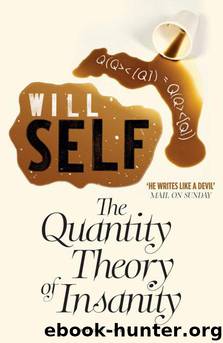The Quantity Theory of Insanity by Will Self

Author:Will Self [Self, Will]
Language: eng
Format: epub
ISBN: 9780679750949
Amazon: 0679750940
Publisher: Vintage
Published: 1996-03-18T16:00:00+00:00
To my mind this expressed with absolute clarity the limiting conditions necessary for a cost-benefit analysis of sanity variables. Of course the informed reader will have already detected the lineaments of Quantity Theory in the structure of the trial diagram. My purpose here is expressly to avoid the crude attempts that are made to retrospectively manufacture the genesis of an idea. The problems I have been most interested in that arose from the Concept House trial were purely methodological. For instance, Olsen’s 1978 paper in the BJE in which he presented the results of his own trials. Olsen took three groups of recently diagnosed and sectioned mental patients. One group was given in equal thirds, lithium, chlorapromasine and a tricyclic anti-depressant. The second group was given a placebo and the third group was given nothing; instead Olsen had the patients in this group mercilessly beaten to a bloody pulp.
If any of the patients in the three groups manifested any signs of severe deterioration in their overall condition they were administered ECT. However, the substance of Olsen’s trial and indeed the validity or otherwise of his results are of little interest to me. Rather it was Olsen’s argument that it was my error in the double negative implied by the double-double-blind trial that exercised me greatly. Fortunately I was saved from having to answer the accusation by the revelation that Olsen had himself participated in administering beatings to the control group in his experiment. Such a violation of the blind status of the trial naturally discredited him entirely.
The trials took six months to complete and during that time I was accepted into the Concept House community. This, as you will hear in due course, was altogether a mixed blessing. Busner and his therapists had long since ceased to make any practical distinction between themselves and their patients. So another involution of the trial sequence was that at the end of it no one could be really sure who had been giving what to whom. The trial money and placebo money were given out at random times when I was sure not to be in the vicinity. Occasionally I would catch a glimpse of a man, skull-capped and be-locked, his apron suspiciously stained and clutching a handful of glossy paper slips. But I discounted these peripheral visions, putting them down to the generally heightened psychic atmosphere of the Concept House.
There were in theory six therapists, six patients, Busner’s parents and myself in residence. The patients were a random selection from the chronic wards that Busner had been attached to over the years. Basically he recruited for the Concept House through a mixture of fraudulence and guile. Busner was typical of experimentalists in the psychiatric and educational fields in that he blamed the failure of his methods not on their theoretical basis, but on the fact that he could only persuade wealthy parents to send their chronically disturbed children to his institution.
I participated in the exhaustive group therapy sessions, which more often than
Download
This site does not store any files on its server. We only index and link to content provided by other sites. Please contact the content providers to delete copyright contents if any and email us, we'll remove relevant links or contents immediately.
The Tidewater Tales by John Barth(12406)
Kathy Andrews Collection by Kathy Andrews(11346)
Tell Tale: Stories by Jeffrey Archer(8703)
This Is How You Lose Her by Junot Diaz(6463)
The Mistress Wife by Lynne Graham(6256)
The Last Wish (The Witcher Book 1) by Andrzej Sapkowski(5232)
Dancing After Hours by Andre Dubus(5118)
The Sympathizer by Viet Thanh Nguyen(4100)
Maps In A Mirror by Orson Scott Card(3730)
The Secret Wife by Lynne Graham(3671)
Be in a Treehouse by Pete Nelson(3655)
Tangled by Emma Chase(3576)
Ficciones by Jorge Luis Borges(3373)
The House on Mango Street by Sandra Cisneros(3235)
Girls Who Bite by Delilah Devlin(3056)
A Knight of the Seven Kingdoms by George R R Martin(3032)
You Lost Him at Hello by Jess McCann(2871)
MatchUp by Lee Child(2702)
Once Upon a Wedding by Kait Nolan(2617)
